Canon EF-S 55-250mm f/4-5.6 IS II Lens Review
Canon EF-S 55-250mm f/4-5.6 IS II Performance
At 55mm, sharpness in the centre of the frame is excellent at maximum aperture, with good levels of clarity towards the edges of the frame. Stopping down improves sharpness towards the edges of the frame with the overall best compromise for clarity being achieved at f/8 for this focal length.Zooming to 135mm actually improves sharpness across the frame, with excellent sharpness in the centre and very good clarity towards the edges of the frame being recorded at maximum aperture. Again, f/8 produces the best compromise for clarity across the frame, with outstanding sharpness in the centre and clarity approaching excellent levels towards the edges of the frame.
Finally, at 250mm, the lens still performs well, producing excellent sharpness levels in the centre of the frame and good levels of clarity towards the edges. Stopping down to f/8 improves sharpness towards the edges of the frame to very good levels.
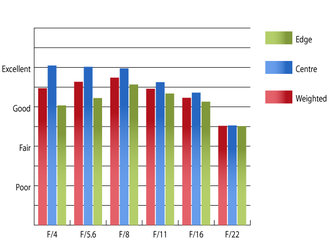 Resolution @ 55mm | 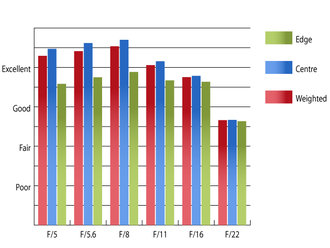 Resolution @ 135mm |
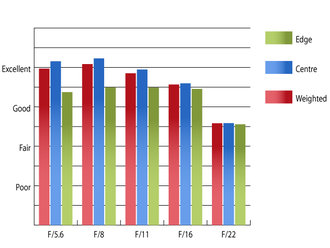 Resolution @ 250mm | How to read our chartsThe blue column represents readings from the centre of the picture frame at the various apertures and the green is from the edges. Averaging them out gives the red weighted column.The scale on the left side is an indication of actual image resolution. The taller the column, the better the lens performance. Simple. For this review, the lens was tested on a Canon EOS 600D using Imatest. |
Chromatic aberrations are reasonably controlled at all focal lengths but 250mm, where fringing can exceed 0.7 pixel widths towards the edges of the frame at maximum aperture. This level of fringing may become apparent along high contrast edges towards the edges of the frame and may require correction in software afterwards in extreme cases.
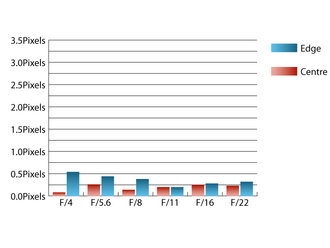 Chromatic aberration @ 55mm | 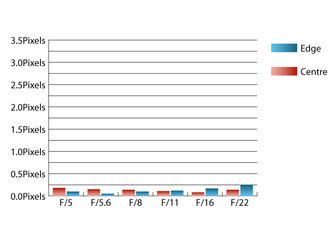 Chromatic aberration @ 135mm |
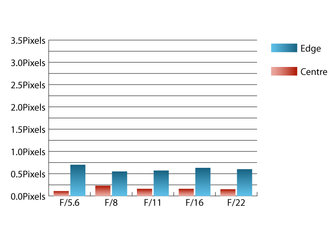 Chromatic aberration @ 250mm | How to read our chartsChromatic aberration is the lens' inability to focus on the sensor or film all colours of visible light at the same point. Severe chromatic aberration gives a noticeable fringing or a halo effect around sharp edges within the picture. It can be cured in software.Apochromatic lenses have special lens elements aspheric, extra-low dispersion etc. to minimize the problem, hence they usually cost more. For this review, the lens was tested on Canon EOS 600D using Imatest. |
Falloff of illumination towards the corners of the frame is well controlled throughout the zoom range. At 55mm the corners are only 1.08 stops darker than the image centre at maximum aperture and at 250mm the corners are 1.14 stops darker than the image centre. Visually uniform illumination is achieved at one stop down from maximum aperture throughout the zoom range.
Distortion is reasonably well controlled with Imatest detecting 0.245% barrel at 55mm at 2.48% pincushion distortion at 250mm. This level of distortion should pose few issues for general photography. If absolutely straight lines are required, then corrections should be reasonably straightforward to apply in image editing software afterwards as the distortion pattern is uniform across the frame.
Few issues with flare were encountered during testing, with only a slight contrast reduction being noticeable when shooting directly into the light, especially at the telephoto end of the zoom range. No lens hood is supplied as standard, so if you require one, then an EW-73B hood will cost around £20.
Add your message
Login required
Please login here or if you've not registered, you can register here. Registering is safe, quick and free.
Please login here or if you've not registered, you can register here. Registering is safe, quick and free.
photodo Stats
1102 lenses
428 MTF tests
74 in-depth photodo reviews
100+ users join each day
Help the lens community by reviewing or rating a lens today via our lens search
428 MTF tests
74 in-depth photodo reviews
100+ users join each day
Help the lens community by reviewing or rating a lens today via our lens search
Latest Lens Reviews
- Chinon 28mm f/2.8 Vintage Lens Review
- Canon EF 70-200mm f/4L IS II USM Lens Review
- Samyang AF 85mm f/1.4 EF Review
- Sigma 70mm f/2.8 DG Macro Art Review
- Samyang AF 24mm f/2.8 FE Review
- Meike 50mm f/1.7 Review
- Tamron 70-210mm f/4 Di VC USD Review
- Lensbaby Burnside 35mm f/2.8 Review
- Asahi Super Takumar 50mm f/1.4 Review
- Asahi Super-Multi-Coated Takumar 135mm f/3.5 Review
